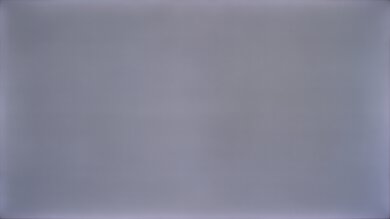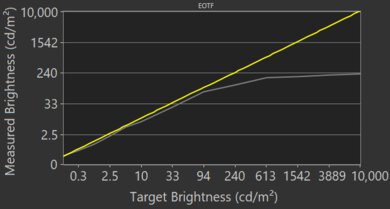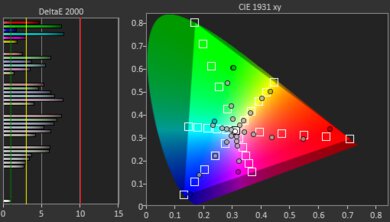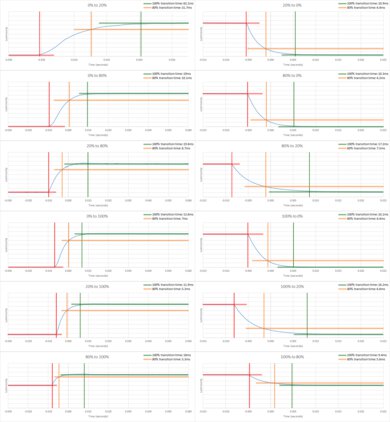The TCL 4 Series 2020 is an okay entry-level TV. It's pretty basic in terms of extra features, but that's expected for a model in this price range, and it performs fairly well for most uses. It has a VA panel with a high native contrast ratio to display deep blacks, so it performs best in dark rooms, but it's not as good for well-lit rooms because it doesn't get bright, and the reflection handling is just decent. Its HDR performance is limiting because it can't display a wide color gamut and lacks a local dimming feature, but if you want to watch lower-resolution content, it doesn't have any trouble with upscaling. Our unit has Roku TV built-in, but there's also a variant with Android TV, the TCL 4 Series/S434 Android 2020, so you can get the one with the smart system you prefer.
Our Verdict
The TCL 4 Series is an okay TV for most uses. It performs best for watching movies in dark rooms because its VA panel has a fantastic contrast ratio, but it lacks local dimming. It has decent reflection handling if you watch shows or sports in rooms with some light, but it doesn't get bright enough to fight a ton of glare. It's okay for gaming because of its fairly low input lag; however, the slow response time results in black smearing. Lastly, HDR content isn't anything special as it can't get bright and fails to display a wide color gamut.
- Fantastic native contrast.
- Decent reflection handling.
- Upscales lower-resolution content well.
- Doesn't get bright.
- Narrow viewing angles.
- Doesn't display wide color gamut.
The TCL 4 Series is okay for watching movies in dark rooms. It has a VA panel with a fantastic contrast ratio that allows it to display deep blacks. However, black uniformity is just okay, and there's no local dimming feature to deepen any blacks. It displays 1080p and 4k content without any artifacts and removes judder from 24p sources, like Blu-ray players or native apps.
- Fantastic native contrast.
- Removes judder from 24p sources.
- Black uniformity is just okay.
- No local dimming.
The TCL 4 Series is okay for TV shows in bright rooms. It has decent reflection handling, but it doesn't get bright enough to combat glare in a well-lit room. It upscales lower-resolution content without any problems, and it doesn't have the risk of permanent burn-in from constant exposure to static elements. Sadly, it has narrow viewing angles, and you quickly lose image accuracy as you move off-center.
- Decent reflection handling.
- Upscales lower-resolution content well.
- Doesn't get bright.
- Narrow viewing angles.
The TCL 4 Series isn't bad for watching sports in well-lit rooms. It has decent reflection handling for when you want to watch in a room with some lights, but it doesn't get bright enough to combat a ton of glare. It has a slow response time that results in some black smear with fast-moving content. It also has narrow viewing angles, so it's not an ideal choice for watching the game with a large group of people.
- Decent reflection handling.
- Upscales lower-resolution content well.
- Doesn't get bright.
- Narrow viewing angles.
- Slow response time.
The TCL 4 Series is okay for video games. It has an incredibly low input lag when gaming with a 4k resolution, but it increases significantly with 1080p content. The response time is slow, resulting in black smearing in dark scenes, and it doesn't have any extra gaming features like variable refresh rate (VRR) support. However, if you game in a dark room, it has an outstanding contrast ratio.
- Fantastic native contrast.
- Low input lag.
- Slow response time.
- No extra gaming features.
The TCL 4 Series is unremarkable for HDR movies. It has a fantastic contrast ratio that results in deep blacks, but there's no local dimming feature to further improve it. Unfortunately, HDR content doesn't look all that different from SDR content because it fails to display a wide color gamut and has bad peak brightness, so highlights don't pop how they should.
- Fantastic native contrast.
- Removes judder from 24p sources.
- No local dimming.
- Doesn't get bright.
- Doesn't display wide color gamut.
The TCL 4 Series is alright for HDR gaming. It provides okay gaming performance thanks to its low HDR input lag, but it has a slow response time that results in black smear. It has a fantastic contrast ratio that makes black appear deep, but HDR content doesn't look good because it doesn't get bright, fails to display a wide color gamut, and lacks local dimming.
- Fantastic native contrast.
- Upscales lower-resolution content well.
- Low input lag.
- Doesn't get bright.
- Slow response time.
- No extra gaming features.
- Doesn't display wide color gamut.
The TCL 4 Series is decent to use as a PC monitor. Its VA panel doesn't have the risk of permanent burn-in, and it displays chroma 4:4:4 with a 1080p or 4k resolution. It also has a low enough input lag for desktop use and has decent reflection handling. However, it doesn't get bright, and it has narrow viewing angles, so the image looks washed out if you sit too close.
- Decent reflection handling.
- Low input lag.
- Displays chroma 4:4:4.
- Doesn't get bright.
- Narrow viewing angles.
- Slow response time.
Changelog
- Updated Sep 26, 2025: We uploaded the latest brightness measurements and uniformity photos for the Accelerated Longevity Test.
- Updated Jul 08, 2025: We uploaded the latest brightness measurements and uniformity photos for the Accelerated Longevity Test.
- Updated Apr 17, 2025: We uploaded the latest brightness measurements and uniformity photos for the Accelerated Longevity Test.
- Updated Feb 11, 2025: We uploaded the latest brightness measurements and uniformity photos for the Accelerated Longevity Test.
Check Price
Differences Between Sizes And Variants
We tested the 55-inch TCL 4 Series Roku TV, and we expect our results to be valid for the 43, 50, 65, 75, and 85-inch models as well. The 85-inch appears to have the same panel, but it has a different body with wide-set feet. We've also tested the Android TV variant, the TCL 4 Series/S434 Android 2020, and it performs very similarly. We aren't aware of any other variants outside of North America.
Walmart sold a Black Friday exclusive model, the TCL 55S20, which appeared to be the same model with Roku TV, but with three HDMI inputs. It was only available in a 55-inch size. There are also two variants of this TV, known as the TCL S431 and the TCL S433. There are no differences between them; these different models exist for different retailers to avoid price matching, but they perform exactly the same.
| Size | Roku Model | 431 Variant | 433 Variant | HDMI | Android Model | HDMI |
| 43" | 43S435 | 43S431 | 43S433 | 3 | 43S434 | 3 |
| 50" | 50S435 | 50S431 | 50S433 | 4 | 50S434 | 3 |
| 55" | 55S435 | 55S431 | 55S433 | 4 | 55S434 | 3 |
| 65" | 65S435 | 65S431 | 65S433 | 4 | 65S434 | 3 |
| 75" | 75S435 | 75S431 | 75S433 | 4 | 75S434 | 3 |
| 85" | 85S435 | 85S431 | 85S433 | 4 | - | - |
If someone comes across a different type of panel or if their TCL 4 Series doesn't correspond to our review, let us know and we'll update the review. Note that some tests, like gray uniformity, may vary between individual units.
You can see the label for our unit here.
Popular TV Comparisons
The TCL 4 Series is an okay low-cost TV, but it's a downgrade from its predecessor, the TCL 4 Series 2019. It doesn't have any trouble upscaling lower-resolution and displays 4k content perfectly, but it has a slow response time that results in black smear. There are better options for gaming in this price range, but if you need a TV for watching your favorite shows, you should be happy with it. The TCL 4 Series/S434 Android 2020 is also a similarly-priced option that performs about the same, but it has Android TV instead of Roku.
Also see our recommendations for the best budget TVs, the best small TVs, and the best Roku TVs.
The Hisense R6090G is better than the TCL 4 Series/S435 2020. The Hisense gets brighter, has slightly better reflection handling, has a quicker response time, and lower input lag. However, the TCL has much better out-of-the-box color accuracy and much better gradient handling.
The TCL 4 Series/S435 2020 and the TCL 4 Series/S446 2021 are both part of the same lineup from TCL, but they have different features. The 4 Series 2020 uses Roku TV and has a VA panel with high contrast, while the 4 Series 2021 we tested has an IPS-like panel with wide viewing angles, but there are variants with a VA panel instead, and it has Google TV. The 4 Series 2021 is a better choice for bright rooms because it gets bright and has better reflection handling, and it has a quicker response time. The 4 Series 2021 also has a motion interpolation feature, which the 4 Series 2020 doesn't have, and it has lower input lag for a more responsive gaming experience.
The TCL 4 Series/S455 2022 is a bit better than the TCL 4 Series/S435 2020. The 2022 version looks a bit better in a dark room, as it has much better black uniformity, with less cloudiness in dark scenes. The 2022 version also gets a bit brighter, and it supports eARC instead of just ARC, allowing you to pass high-quality lossless audio signals through to your connected soundbar or home theater receiver.
The TCL 4 Series 2019 is slightly better than the TCL 4 Series/S435 2020. They're very similar TVs, but the 2019 model has a much quicker response time and lower input lag. However, the 2020 model removes judder from native apps and has much better out-of-the-box color accuracy.

We buy and test dozens of TVs yearly, taking an objective, data-driven approach to deliver results you can trust. Our testing process is complex, with hundreds of individual tests that take over a week to complete. Most of our tests are done with specially designed test patterns that mimic real content, but we also use the same sources you have at home to ensure our results match the real-world experience. We use two main tools for our testing: a Colorimetry Research CR-100 colorimeter and a CR-250 spectroradiometer.
Test Results

The TCL 4 Series is a basic TV with a simple, no-frills design. It looks a lot like the TCL 4 Series 2019 with a different pattern on the back. It has wide-set feet, and the overall build feels cheap.
Update 01/13/2021: We remeasured the footprint of the stand because we originally measured it with the feet twisted outwards, creating a larger footprint. However, this isn't another position you can place them on, we had just placed them incorrectly.
The wide-set stand is made of plastic, and the TV wobbles a bit. The position of the feet can't be changed to accommodate smaller tables.
Footprint of the 55 inch TV: 38.7" x 12.2".
Note: There's an 85 inch model whose feet are placed at the left and right edges.
The back of the TCL 4 Series is different than the TCL 4 Series 2019. The back panel is made out of metal that feels a bit cheap, and the part where the inputs are is also made from cheap plastic. Sadly, there's no cable management.
Note: There's an 85 inch model with a different back, somewhat similar to the TCL 6 Series/R635 2020 QLED.
The TCL 55S435 is somewhat thick, but should still look good when wall-mounted.
Note: There's an 85 inch model with a different back, somewhat similar to the TCL 6 Series/R635 2020 QLED, so it may be a bit thicker.
The SDR peak brightness is poor. It doesn't get bright enough to combat glare in well-lit rooms. Luckily, its brightness is very consistent across different content.
We measured peak brightness after calibration in the 'Movie' Picture Mode. If you don't care about image accuracy and want the brightest image possible, we reached 268 cd/m² in the 2% window in the 'Vivid' Picture Mode.
If you want a budget-friendly TV that gets brighter, check out the Hisense H6510G.
Update 08/02/2021: Added the real content local dimming videos.
It doesn't have a local dimming feature. The video is for reference only, so you can see how backlight on this display performs and compare it to a similar product with local dimming.
Update 08/02/2021: Added the real content local dimming videos.
Once again, there's no local dimming feature. The video is for reference only, so you can see how backlight on this display performs and compare it to a similar product with local dimming.
The TCL 55S435 has bad HDR peak brightness. It doesn't get that much brighter than in SDR, and it's not enough to make highlights pop in HDR. Small highlights are a bit dimmer due to frame dimming. The EOTF follows the target curve somewhat well until the roll-off, but most scenes are a bit too dark.
We tested HDR peak brightness in the 'Dark HDR' Picture Mode with TV Brightness set to 'Brighter'. If you find it too dim, set Gamma to '1.8' in the mobile app because this results in a bit brighter scenes as seen in this EOTF, but the peak brightness is about the same.
The HDR brightness in Game Mode is once again disappointing. It looks the same as outside of Game Mode because you don't need to change the Picture Mode to enter Game Mode. It's not enough to make highlights pop the way the creator intended.
Our unit of the TCL 4 Series has okay gray uniformity, but this may vary between units. The edges of the screen are noticeably darker, and there's dirty screen effect (DSE) in the center, which could be distracting during sports. There's less DSE in near-dark scenes, but there's visible backlight bleed along the edges.
This TV has alright black uniformity, but this may vary between units. There's a bit of blooming around the center cross, and sadly, there's noticeable backlight bleed along the edges. This can be distracting in dark scenes, and there's no local dimming feature to improve it.
The TCL 55S435 has narrow viewing angles, which is expected from a VA panel. You quickly lose image accuracy as you start to move off-center. If you want a budget-friendly TV with wide viewing angles, look into the Hisense A6G.
This TV has excellent out-of-the-box color accuracy, but this may vary between units. There are hardly any inaccuracies with most colors and white balance, but some blues are a bit off. Gamma follows the target curve fairly well, but most scenes are too dark. Lastly, the color temperature is a bit warm, giving the image a red/yellow tint.
The accuracy post-calibration is simply incredible. Any remaining color inaccuracies are fixed except for red, and the color temperature is nearly spot on with our 6500K target. Gamma isn't perfect, as some scenes are slightly over-brightened, but this shouldn't be very noticeable.
You can see our recommended settings here.
Update 12/15/2020: We retested the 4k input to see if there's any spatial dithering because there's some crosshatching in the shadows. We tested other pictures and didn't notice any spatial dithering.
There aren't any artifacts with native 4k content as this TV displays it perfectly. It looks more like the TCL 5 Series/S535 2020 QLED than the TCL 4 Series 2019.
Some of the blue pixels appear dimmer, but this doesn't result in any picture quality issues. This TV uses a BGR subpixel layout, which can affect the way text is rendered when using the TV as a PC monitor. You can read about it here.
The TCL 55S435 has an okay color gamut for HDR content, but it's not considered a wide color gamut. Even though it has good coverage of the commonly-used DCI P3 color space, its coverage of the wider Rec. 2020 is limited.
The TCL 55S435 has a disappointing color gamut. It's mainly limited by its lack of wide color gamut and low peak brightness, as it can't display colors at a wide range of luminance levels.
The gradient handling is impressive, but it's not as good as the TCL 4 Series/S434 Android 2020. Most of the banding is visible in the darker shades, especially in the grays and greens. There's a Noise Reduction setting available in the Roku mobile app, but it doesn't improve the gradients at all.
We don't expect VA panels to experience permanent image retention, as the VA panel in our long-term test appears immune.
This TV has a mediocre response time. Motion looks blurry because the response time is slow in most transitions, especially with dark transitions, which causes black smearing. This can be noticeable in games or movies with fast-moving content in dark scenes.
There's no optional black frame insertion feature. The TV flickers at 120Hz if you set the Backlight to '18' or below.
This TV doesn't have a motion interpolation feature.
Due to the slow response time, lower-frame rate content doesn't appear to stutter.
This TV automatically removes 24p judder from native apps or Blu-ray players.
It doesn't support any variable refresh rate technology.
This TV has low input lag, but it's not as low as some other 4k TVs, especially if you're playing 1080p games or if you need the TV to display chroma 4:4:4, like if you're using it as a PC monitor. You likely won't notice much of a delay in those situations, but it can affect your gaming performance with reaction-based games. It's best to play 4k games at 60fps with chroma 4:2:0, as you won't notice any delay.
Note: We couldn't measure the 1440p @ 60Hz input lag because it can't display a custom 1440p resolution from a PC, but it does from an Xbox.
This TV supports common resolutions up to 60Hz. It accepts a 1440p @ 60Hz signal from an Xbox, but it displays a green screen and has issues when forcing that signal through a PC. It properly displays chroma 4:4:4 with either 1080p or 4k content, and you don't need to change any settings for it to work as it automatically displays it when connected to a PC.
Since it's limited to a 60Hz panel and has HDMI 2.0, it can't take advantage of the full capabilities of either the Xbox Series X or PS5. It has an Auto Low Latency Mode, and there aren't settings for it; it switches the TV into Game Mode when a game from a compatible device is launched for low input lag.
The Composite In input needs an adapter, but it doesn't come with one like the TCL 4 Series/S434 Android 2020.
The frequency response is mediocre. It has a fairly well-balanced sound profile but doesn't produce much bass. It gets loud, and there isn't much compression at its max volume.
This TV has okay distortion performance. There isn't much distortion at moderate listening levels, but it gets a lot more audible at its max volume. However, this depends on the content and not everyone may hear it.
The TCL S435 variant we tested has built-in Roku TV, but the TCL 4 Series/S434 Android 2020 variant has Android TV instead. Note that we tested this TV around the same time as the U.S. elections, and the background was automatically set to an American theme. This is why the background is different than other Roku TVs we've tested in the past, which had red backgrounds, but you can change it in the settings.
The newer version of this TV, the TCL 4 Series/S446 2021, uses Google TV instead of Roku.
There are ads and suggested content on the home page, but we couldn't get a picture. You can opt-out of featured content by selecting Limit Ad Tracking in the 'Advertising' section of the Privacy settings.
This TV comes with the same basic remote as the TCL 3 Series 2020. It doesn't have voice control, and there are some quick-access buttons to popular streaming devices. You can use voice control through the Roku app on your phone, and you can ask it to change inputs, open apps, or search for specific content.















































